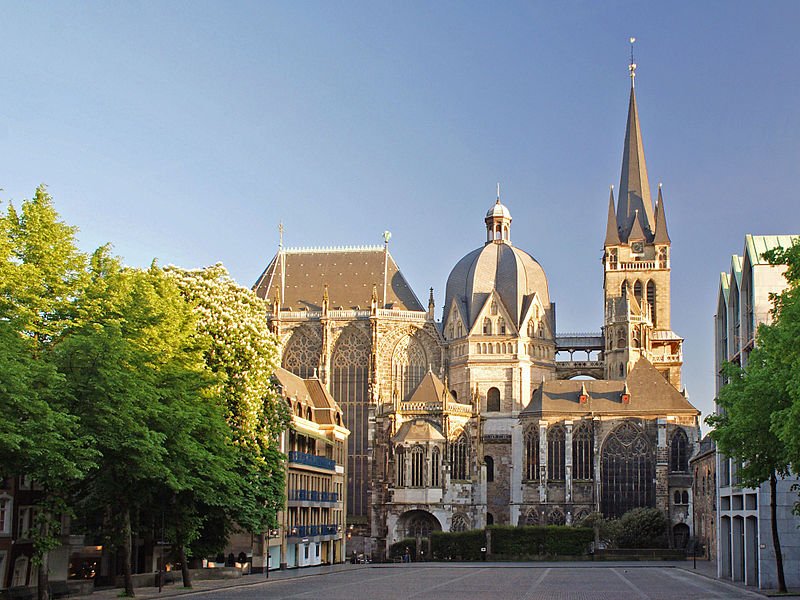 Aachen Cathedral
Aachen CathedralSource: https://commons.wikimedia.org/wiki/File:Oochen-Kath--Nords%C3%A4it-g%C3%A9int.jpg
Author: Aleph

Aachen (French: Aix-la-Chapelle, is a city in North Rhine-Westphalia, Germany. It is the westernmost city in Germany, located on the border with Belgium and the Netherlands. Aachen covers 160.83 sq km (62.1 sq mi) and has a population of 259,000 (2011 estimate). The city is on an average elevation of 266 m (873 ft) above sea level. It is within the Central European Time Zone, which is UTC+1, and in summer the Central European Summer Time Zone, which is UTC+2.
Aachen is home to RWTH Aachen University, one of the premier universities of the country. Aachen Cathedral was historically the place of coronation for German kings and the favoured residence of Charlemagne. In 1373 it became the first coin-minting city in the world to place an Anno Domini date on its coins. The modern city of Aachen ranks among the top cities in Germany for engineering, information technology and science.
 Aachen Town Hall
Aachen Town HallSource: https://commons.wikimedia.org/wiki/File:Aachen_Rathaus_vom_Katschhof.jpg
Author: Lokilech

As a tourist destination, Aachen is famous for its hot spring, whose therapeutic properties have been recognised as early as Roman times. The Aachen area has been inhabited since Neolithic times. Under the Romans, a settlement was built here named Aquis-Granum. Charlemagne first came to Aachen in AD 768. He liked the town so much that he spent most winters there, from 792 until his death in 814.
The church which Charlemagne built in Aachen later became the Aachen Cathedral. Beginning with Otto I in 936 AD, some 30 German kings and 12 queens were to be crowned at Aachen Cathedral to reign as rulers of the Holy Roman Empire. The city went into decline in the 16th century, further compounded byu a devastating fire in 1656. On the other hand, the city became a popular spa town since the mid 17th century, not so much for its therapeutic springs, but rather because it also became a place of high-level prostitution, which remained till the 19th century.
 Aachen Theater
Aachen TheaterSource: https://commons.wikimedia.org/wiki/File:Aachen_Theatre.jpg
Author: Martin Möller

Aachen was shoved to be a backwater city when it fell under the control of the Kingdom of Prussia in 1815, following the Napoleonic wars. It suffered from overcrowding as well as miserable living conditions. The city was further devastated during the Second World War, which destroyed many of its valuable churches including St Foillan, St Paul and St Nicholas as well as its city hall. The Aachen Cathedral is still standing and is well preserved. Today it is designated as a World Heritage Site.
Visiting Aachen, Germany
There are high-speed Thalys and ICE trains that connect Aachen with Liege and Brussels. Regional express trains also connect Aachen with Cologne and Düsseldorf. The nearest airports are the ones at Düsseldorf and Cologne-Bonn. From there, you can take trains to Aachen. Couven-Museum, Aachen
Couven-Museum, AachenSource: https://commons.wikimedia.org/wiki/File:Aachen_Couvenmuseum.jpg
Author: Norbert Schnitzler

Places of Interest in Aachen
- Aachen Cathedral: Site of coronation of German kings, it is the memorial and burial place of Charlemagne (whose tomb is unfortunately lost).
- Couven-Museum: Museum that offers a glimpse into the life of the bourgeoisie in the 18th and 19th centuries.
- Internationales Zeitungsmuseum: Museum devoted to the history of newspapers, with some 100,000 in its collection.
- Pfalz: This is a collection of buildings that formed the palace complex of Charlemagne.
- Rathaus: The medieval town hall, damaged during the Second World War, is now restored.
- Suermondt-Ludwig-Museum: Museum with a collection of art from the Middle Ages until modern times.
 Latest updates on Penang Travel Tips
Latest updates on Penang Travel Tips
About this website

Thanks for reading this page. My name is Timothy Tye. My hobby is to research information about places, and share the information with people on this website. I started this website on 5 January 2003, and since then, have written about over 20,000 places, mostly in Malaysia and Singapore.
Please use the information on this page as guidance only. While I try my best to provide you information that is as accurate as I can get it to be, I do apologize for any errors. Also, as I might not be able to update some information on time, some of these pages may contain outdated information.
Copyright © 2003-2024 Timothy Tye. All Rights Reserved.


 Go Back
Go Back